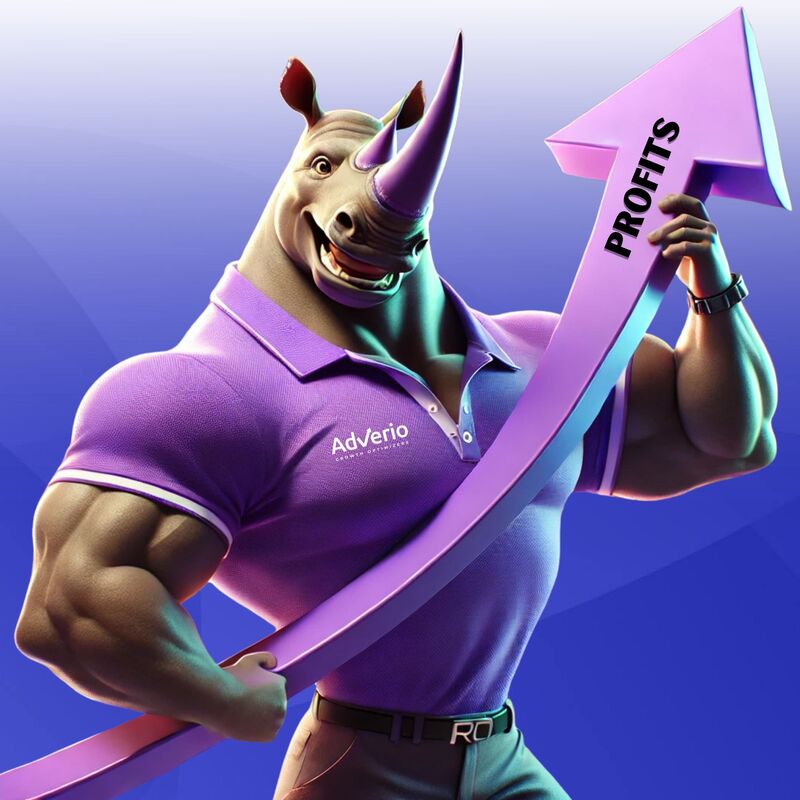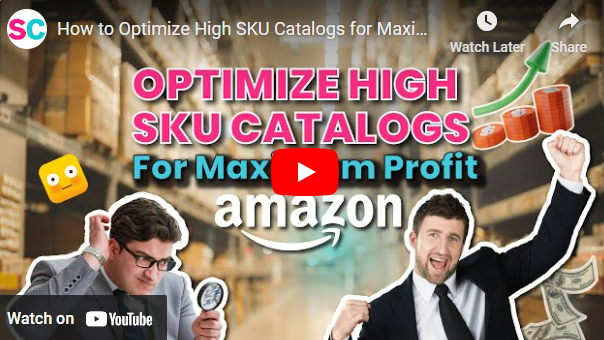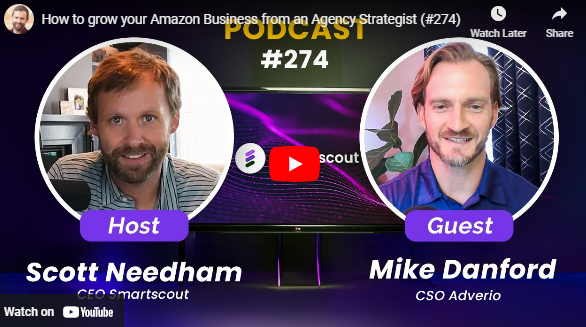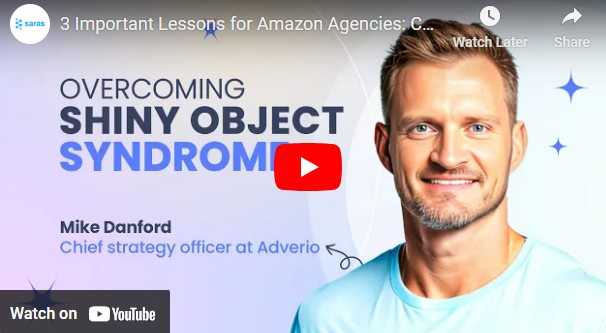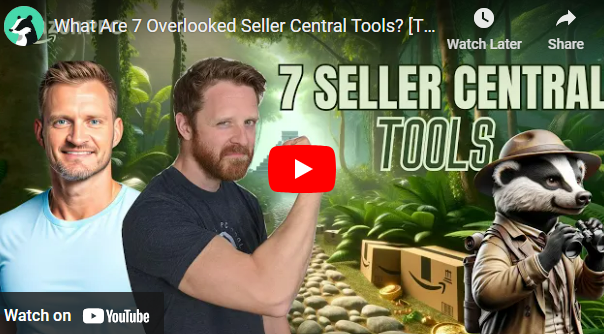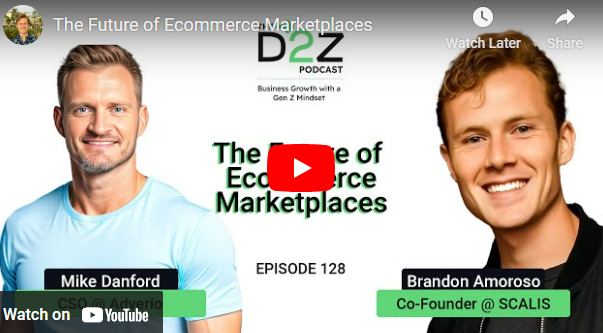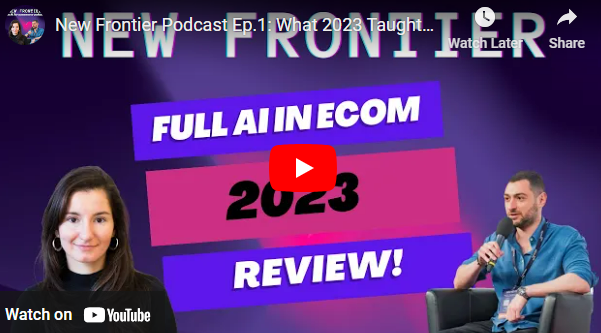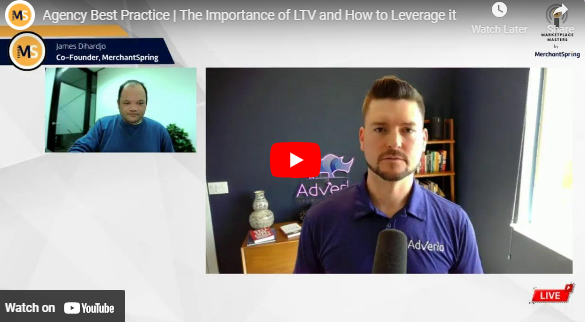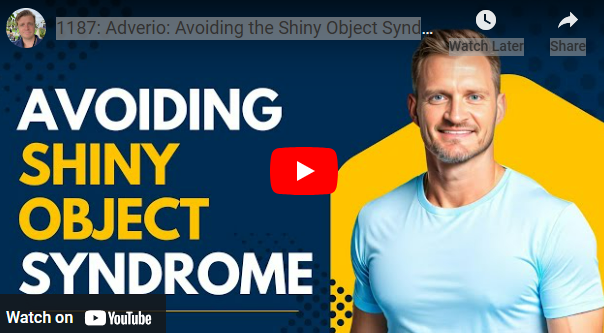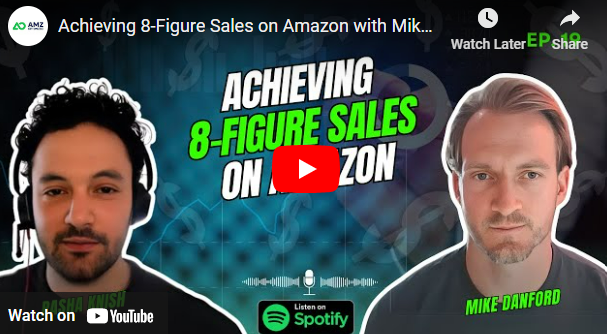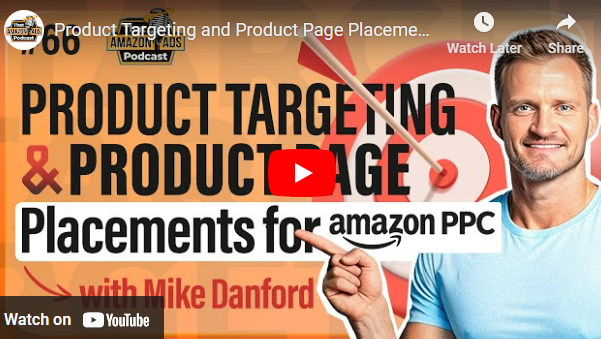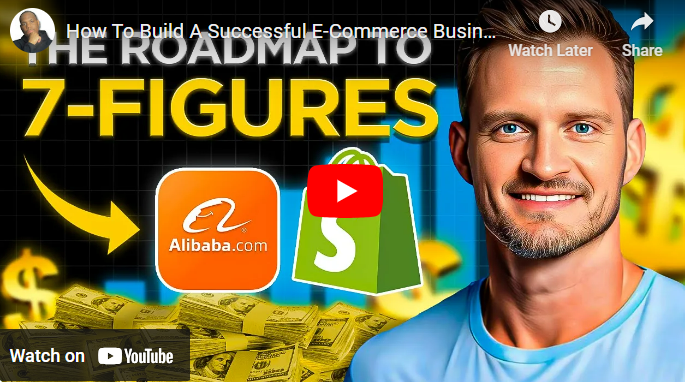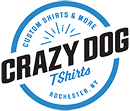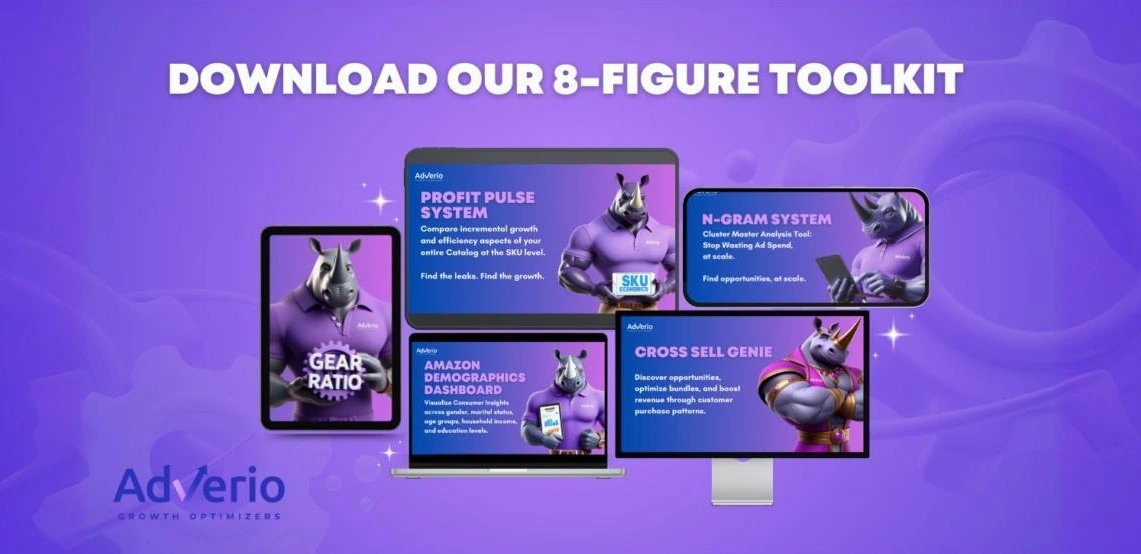Agency Operators Podcast
Uncovering the Paths to Success from Agency Owners
In this episode, Pasha and Mike Danford from Adverio discuss the evolution of ecommerce strategies and tools over the years.
Mike shares his journey from risk management in insurance to mastering ecommerce and digital marketing. They explore the importance of leveraging technology, various marketplaces, and advertising strategies to scale ecommerce brands from seven to eight figures.
The conversation covers topics such as Amazon PPC, influencer marketing, Google Performance Max, and strategies for using advanced platforms like AMC and DSP. Finally, Mike offers a valuable resource for listeners—a checklist of tools to help brands enhance growth and overcome stagnation.
- 00:00 Introduction and Guest Welcome
- 00:43 Mike’s Journey to Adverio
- 02:27 Evolution of Advertising and Marketing
- 03:56 Technological Advancements in Advertising
- 07:04 Team Building and Scaling Challenges
- 12:07 Navigating Marketplaces and Expansion
- 20:15 Strategies for Driving Traffic and Sales
- 22:59 Challenges with Amazon Attribution
- 23:14 Strategies for Accurate Attribution Data
- 24:32 Understanding and Utilizing AMC Data
- 25:21 Leveraging DSP and AMC for Insights
- 27:12 Moving from Seven to Eight Figures
- 27:49 Effective Marketing and Advertising Tactics
- 29:37 Basics and Fundamentals for Growth
- 30:03 Importance of Market Basket Analysis
- 33:28 Influencer and Affiliate Marketing Strategies
- 36:06 Tracking and Analyzing Influencer Campaigns
- 40:49 Final Thoughts and Resources
[00:00:00] Pasha Knish: Hey
everybody, Agency Operator Basha here with Mike Danford. Good old friend of mine from Adverio. How you doing Mike?
[00:00:15] Mike Danford: Great. Thanks for having me today.
[00:00:18] Pasha Knish: Awesome. So glad you made it. Um, looks like we have a couple of different things to talk about, but, um. You and I have known each other for a number of years.
We’ve had many calls talking about all kinds of things from what’s working, what’s not working, how things are changing. And so I think there’s a lot of good conversation there. But before we dive in, um, could you share a little bit about your story? And how you ended up being with Adverio for all these years and your position has changed quite a bit too.
That’s been kind of cool to watch that transformation. So share what you can.
[00:00:49] Mike Danford: Yeah, absolutely. Thanks for the opportunity. So I’ve been in the space for about 12 years and I studied undergrad for risk management insurance, spent several years in insurance, and then, um, had fun, but I contracted MRSA and was like, Hey, this is not really what I want to do for the rest of my life.
So I started out, um, getting into real estate and I said, Oh, okay. About that time is when the Amazon, you know, getting on the FBA was a big thing. Went through, I think it was the amazing selling machine ASM, if I remember correctly. Um, so that was kind of the way to get into it at that time for a lot of us.
And, you know, we started my own business, our own FBA store and, you know, realized that there’s a lot of opportunity there. I was having someone run my, my advertising and marketing, which was a lot less sophisticated at that time, admittedly. And it was like, Hey, this is just numbers. You know, you didn’t really couldn’t even do copy or headline, uh, headlines or anything of that nature, creatives, et cetera.
So I was like, Hey, I can figure this out. So started doing that. And, you know, thanks for Facebook groups, et cetera, posted and sharing success and tactics and whatnot. And a few words like, Hey, I’d love for you to be able to do that for me. Would you do it? Sure. Um, you know, kind of the rest is history from there, where it’s like, okay, how about packages?
How do I do this? Etcetera. And then, you know, to your point with my role, you know, I was on my own for a few years. And then started doing some white labeling and working for other agencies or other providers and et cetera. But I didn’t really want to get into the marketing side of it. I just like, I just want to do the PPC and the algorithms before all the Sasson platforms came out.
Um, and then I, I bumped into to Alden, which my partner at Averio, and we kind of had 2 businesses in real lines. We’re kind of not really competing with each other, but playing the same box. Um, et cetera. It’s like, Hey, we could do more if we come together. Um, so the rest is history from there. But as far as the role change, it’s still changing.
It’s like almost every day it evolves. It’s like, Hey, there’s a new opportunity. Let’s figure this out. And you all say that the where we kind of missed herself is working with mid seven figure to mid eight figure brands. That are stagnant or having some kind of decline in the revenue or inability to launch new products, et cetera.
And I’m like, Hey, what used to work 10 years ago doesn’t work now. How can we do this? And then, you know, a large pain point for them is prioritization. You have, you know, we work with very large catalogs where we have some brands that have tens of thousands of products or others will have a couple thousand and that becomes really challenging.
Um, so we built systems for that to leverage for those brands and that’s been fun. That’s definitely one of the hats that I wear. I love the challenge. I love the tech that has developed over the last 12 to 15 years that makes a lot of this easier to share with other brands and agencies, etc. I love where I’m at now.
I’m not sure what the next 5 or 10 years will look like. It’s kind of hard to see past your nose sometimes, but definitely excited to continue on my path.
[00:03:46] Pasha Knish: And you guys were really working on some kind of cutting edge technology. Uh, back in those days, I remember when we first met, you were sharing all these systems and it was pretty robust.
And, and I’m just curious how that has changed with all the new upgrades. Like you said, things have evolved on the tech side quite a bit. And so your systems naturally have probably evolved too. And then, you know, with the addition of additional marketplaces and other services that you guys have added, uh, how, how has the tech part really kind of caught up with it?
[00:04:19] Mike Danford: Yeah, that’s great. Uh, you know, we were one of the first, I guess, at least in, in our group that dug into having our own, uh, you know, GPT, uh, API access on the backend before it even really became mainstream and understanding what large language models are and how to impact from, you know, Um, SEO to advertising to et cetera.
Like how can we scale, you know, we have 80, 000 products for a brand that we need to, we can’t go manually into each of these campaigns and I’m sorry, each of these, um, you know, titles, bullet points, et cetera, and do it. So how do we create like these recipes and hit the burrito? Um, obviously we can see some of that happening with some of these other AI platforms that are out there with SEO and titles and like, eh, that really isn’t good.
Like I just saw one that smart scout posted earlier today, I think, or maybe it was yesterday. And it was, um, the, the death water where, Hey, they’re clearly using AI and it’s a big name brand, obviously, you know, unique marketing aspect and stuff. So that’s definitely the, the, the big part is able to do more.
It’s just, how do you moderate it? Like the moderation is definitely the most challenging part now. So. With that, you know, it’s always trying to improve it. The more access, the more data that we have under our purview, the better it becomes. The more we see things, I can also start to see trends from that because when we do things, hey, this isn’t really working anymore.
Why is that? Oh, well, Amazon’s changed this or this category has a very unique limiting factor or hey, you can’t it’s better to have fewer characters and more characters for this or, you know, we’re digging into Walmart and Walmart has a really good guide on, you know, hey, it should be Brand name, product name, use attribute, one keyword, those kinds of things, those little formulas.
We kind of bring those back into Amazon. Um, and you know, did not change the back end keywords, you know, add to 50, remove two 50, that kind of stuff. So it’s, it’s definitely staying on top of it. Um, you know, I’d say like. As a little bit of plug, one of our new exciting projects that I’m not really sure where it’s going to go.
It’s something we played around with is Amazon’s recognition software, which is their AI. So it’s basically scanning all your images and videos that are on your listing, any ads, etc. And it’s scraping the text from that. And that’s how we’re, we’re looking at another way of indexing, improving like a hidden indexing, um, for listings and making sure that Amazon knows from our images, what’s the most relevant, um, searches to go after.
How many, how many keywords can we place in there? Does it make sense to duplicate or where are we putting an image? Um, et cetera. Like, do we get duplication of the same keyword or same word in the image? And how do we do that? So that’s. Lot of fun. And that’s directly from Amazon. So it’s pretty cool to see behind, you know, behind the scenes under the hood of this is what they are standing or reading in these in these images.
And how can we improve those?
[00:07:00] Pasha Knish: Yeah, pretty amazing how there’s all these little nuances for optimization, right? Like little tweaks like that, like putting in keywords into the metadata of an image can have such a big impact on your catalog and your ranking, right? And so it’s, it’s kind of, The only real way that you can get ahead once you get to a certain level, like if you guys are working with those seven figure sellers, any micro detail like that could give you that edge.
So that’s super cool. And, and also I know that back in the day, you guys were really more focused on the PPC side specifically for Amazon. And now it’s gotten more involved with content, catalog optimization, and now these other platforms. Um, so it must be that you guys have pretty like built a pretty robust team at this point.
Um, how was that just like that scaling process, like manpower, managing all the people, mid level management and getting all that sorted? I mean, that’s the real hurdle, isn’t it?
[00:08:01] Mike Danford: Yeah, that’s definitely where, you know, part of the role changes. Um, and like I said, I mentioned, I listened to, uh, to Stephen’s.
Appearance, I think it was last week, et cetera. And he was, you know, I liked how he mentioned, you know, eight person per person, eight people under one person is kind of a capacity. And that’s just trying to figure that formula out, um, as well. And it just helps with, you know, balancing. That’s more of an HR role that I’m not used to.
So we have an operator that comes in and helps us with that. just to kind of understand, make sure we’re within capacity and how roles change. You know, similar to what we’re talking about, how tech has changed. You’re still in the same space, but it’s what part of the tech levers you’re pulling are different.
It’s the same way with with our human capitalists. Hey, Yes, you’re still creating images. You’re still creating, you know, copy or managing advertising, but you have these other tools and it’s now what can you do the most with your time or where do you get the most squeeze the most juice for your squeeze now?
And that’s always we’re trying to ask for ourselves. And similarly, you know, it’s it’s it’s. Trying to to create or expand a service line and give that, you know, that freedom and autonomy to someone that maybe don’t have the years of experience with or working alongside of. Um, so we try to promote within before we bring someone new in, um, and that works out pretty well.
And it’s just, you know, nice to have someone that has a background that specifically may have built a product or an offering that It’s exactly what we’re looking for. And they’ve done it, you know, once or twice. We’ve worked with, I wouldn’t say a competitor, but someone that kind of has a generally, you know, similar offer in certain aspects of it.
And then just trying to give them the freedom and autonomy to create within their own domain. Hey, um, you have, we have data scientists, you have access to them. If you feel like this is, if you ask yourself, Is this? This is really boring. This is challenging. I don’t like having to sit here and do this.
Click this button. You come over to data scientists and see if they can fix it for you because we don’t want you doing it. We want you to want to enjoy your job and to focus on things that are more impactful in the business or where the human element needs to be there and get rid of the automation or improve the automation.
So it’s an ongoing process. You know, I would say if I could do it over again, it would be bring in an operator much sooner than we did. Um, you know, kind of wearing that hat in the beginning was okay, but then I’m not, that’s not my, my strongest suit, if you will, definitely an implementer, but, you know, systematizing and building outside of, you know, what I’ve been exposed to is definitely, was definitely a challenge when you bring someone in that has, you know, Build multiple agencies, whether it’s a marketing agency or other type of creative team, man.
It’s just an eye opening what they bring in all the questions. Very similar to what we do for advertising, right? We see hundreds of brands, um, we’re not just pigeonholed or focused on, you know, one set of campaigns or one set of products or one category, but hey, we get to see hundreds of categories, hundreds of thousands of products.
This does not work. It’s never worked or, Hey, this usually works or, Hey, this works all the time. And we’re able to bring that similarly. I love that. And we can bring someone that has that experience. It hits it’s the learning curve is so much shorter for our team, uh, for myself. Um, and I love being able to ask the team to help me in areas where I’m like, Hey, this is not my strong suit.
I haven’t done this in a while. We were talking the other day on our marketing team. Like I’m stuck in web 1. 0. Like sometimes I go back and this is how we used to do blog articles back in, you know, early two thousands and it’s totally different now, right? Um, but it’s always fine. So it’s definitely, you know, growing pain for sure.
[00:11:27] Pasha Knish: Yeah, absolutely. I think in my agency, what I’ve found has worked pretty well is really having like a strategist that has that experience and building an entire workforce around them because they know their things, they know what moving parts to put together and the learning curve is just so much shorter, like you said.
Uh, and I think that generally that seems to be the way that things are moving now, because there’s so many. People that want to do contracting and, you know, agencies are at different stages and so you can’t always offer like a full time position at the super high salary with benefits and you’re just kind of growing.
So there just seems to be a lot of fractionalized opportunity that people are giving one another. And as long as it works and the job is getting done, then it just evolves. So it’s an interesting paradigm that we’re in, I think, 10, 15 years ago, building a company and hiring was a totally different thing than it is today.
Uh, and people are just more open to building schedules on the internet and, you know, hiring remote, even across the world, if you need to, as long as, like I said, if the job is getting done, it’s getting done. Right.
[00:12:33] Mike Danford: Absolutely. You mentioned, you know, it’s how it’s changed the last 10 to 15 years. One, where to find talent, how to bring them in and this whole like gig economy.
And then obviously COVID kind of spread that if you will. Um, you know, and I think you and I’ve talked in the past where like LinkedIn has been phenomenal for us to, to find talent, um, that’s already engaged with this kind of knows us. We kind of like, we know them, um, and we can kind of see their past, um, you know, interactions and how did they create content, how do they think, et cetera.
And then it’s just. a way to cut down the noise, um, as opposed to using like a zip recruiter or something where others probably have great success with that. It’s just not for us. Um, but it definitely changes for sure.
[00:13:11] Pasha Knish: Yup. Absolutely. So with regards to the other marketplaces that you guys are kind of expanding into, you mentioned Walmart.
I know there’s a couple of other ones, um, from the data that you guys are collecting, what are you seeing? In terms of those marketplaces in comparison with Amazon, is Amazon still going to be, you know, number one forever? Or do you see that kind of shifting? Not crystal ball, you know, 2024 is Amazon dead type of question, but I mean, generally other marketplaces, they have their Uh, they have their, you know, corner of, of things.
So people want to go there for some specific reason that, you know, Amazon is not serving that function, even though Amazon tries to do everything. So, uh, I’m just curious, you know, how much opportunity really is there outside of, Oh, I have my website. I have my Amazon channel. Is it worth it to do anything else?
[00:14:03] Mike Danford: Yeah, I’ll answer or I’ll share something and then kind of come back and answer that directly. So I was reading, I think it was a couple of weeks ago and I might misquote the brand. I want to say it was the spike ball brand or something of that nature, like a seasonal summer seasonal product that obviously blew a lot of virility and just cool product.
We even have one right? And, um, You know, he, he’s kind of going against the grain right now, or think about going against the grain where they start out DTC. I don’t think they actually are available. I don’t sell directly on Amazon right now. Um, and under in retail and some other places as well, you know, the, the gist that I got from his post and his question, and then maybe I’m missing a turn.
Misunderstood it, but regardless is having all the channels and managing everything that comes with DTC when you’re doing it yourself and it’s, it’s still enticing for even, you know, a large brand like that to come back to Amazon and just simplify things. It’s like, Hey, I’m gonna ship everything just in Amazon.
Yes. The fees may be different, maybe more, whatever it may be. And I’m kind of beholden to them, but. Life is just simpler. Operations are just simpler. I don’t have to shift to here, hold here, push here, wait for this, or oh, this, you know, it’s just, or we have a different UPC versus a FNSCU or a barcode or whatever it may be and it’s changed packaging or I can’t put the insert into my Amazon because it’s not allowed to do that versus my DTC where I can kind of promote, etc.
So, um, very interesting to see that. I think you’re going to have a lot of interest. Um, transition both ways from more of a DTC model DTC model coming over to the marketplace and they’re gonna have people who are kind of like, hey, I don’t want to pay the 30 40 percent or whatever category is up to now some 50 percent right to I’m gonna go over to DTC and see if I can cut that.
See if the grass is greener on the other side. Um, we do see that. You know, for us specifically, it’s, it’s about, you know, taking a brand that most, most commonly is already on Amazon, getting them on to the Walmart or target if they have invitation, um, then obviously helping them with their DTC traffic and kind of understanding what the campaigns are and kind of, um, helping separate that, that data.
Um, when you start coming across platforms, understand, you know, is the time raising all shelves, right? Um, that’s definitely a challenge, you know, it’s, and, and with that, it’s very category specific, even target is very limited in what they’ll take in right now, because I guess it was a year and a half ago, right before Christmas, where they had to liquidate, move a lot of inventory, because it didn’t move in Q4.
And they’re like, Oh, we missed that, right? So now we’re like, we’re just looking at pet and baby brands, the ones that really kind of work for this. Um, And it’ll just be interesting to see, you know, for the Walmarts, you know, a brand that does extremely well on Amazon or their own website may not do well on Walmart because of the target audience and, and, and locations and, and, and that they would, they have a, a, um, a Walmart subscription versus an Amazon subscription versus not, et cetera.
Um, there’s no, there’s no one size fits all. It’s, you know, it’s definitely a lot more due diligence to understand. You know, we used to say five to 20 percent of your revenue on Amazon, you could get on Walmart. Well, we’re seeing brands with 40, 50, 60 percent on Walmart versus Amazon, but it’s so, so random.
We’re still trying to work on like, Hey, how do you know that? Like that’s. How did you have, how can you anticipate that? Um, and we have some theories, but obviously trying to get the data to back it up to, to better, um, solidify that, but it’s definitely a fun process. And then, you know, a brand that’s on Walmart, Target and, um, Amazon, each platform will, we perform totally different.
What works on one platform doesn’t even work on the other. And they’re all marketplaces. You know, we have brands that’ll come to us and they’re like, Hey, here’s our top 200, 300 keywords in Google that have done really well on DTC. I appreciate that. just be prepared. That’s probably not your how the search traffic is inside of Amazon.
There may be some overlap, a little bit in diagram, if you will, but, um, and then vice versa going out. So like, Hey, whoa, you really got to speak more and engage more and say, why us? Like right in the beginning, um, because they’re not there may be window shopping as opposed to just shopping or they’re not as far down the funnel when they’re on Google or depending on where the placement is, et cetera.
So that’s definitely interesting. And then, You know, on that from Google, DTC, et cetera, um, you know, the, the new release he just pushed out where, you know, Google will now allow you to do the e com, I’m sorry, the, the performance max directly to your listing as opposed to having to go through your website or some other stuff.
So it’s really cool to see the two giants kind of figure out how to create less friction. We’re in the game together, maybe. Or they’re in the game together, if you will. Um, so
[00:18:41] Pasha Knish: cool. So if I had to ask you, right, you’re doing well on Amazon, us, and you had a choice between expanding to other marketplaces, target, Walmart, or going to the EU and tackling the EU five, you know, shipping, doing all the VAT compliance, all that stuff, right?
To at least to. Places, you know, cause of Brexit, you have to ship to the UK, other EU territories. So that’s obviously a big headache, big investment of inventory, but the opportunity is pretty big there. Or you say, all right, let me just take more market share in the U S on these other platforms. Knowing what you know, what would be your option?
[00:19:18] Mike Danford: It’s going to be going to other marketplaces in your, um, demographic region, or I’m sorry, your geographic region that you’re already in, you already have the infrastructure for. It’s much easier. We’ve seen for you to ship an extra shipment over to this warehouse or move it from this warehouse and place it here.
Once you go across the pond, or even once you go across the northern border, we have a brand, an eight figure brand that, um, You know, like, man, how do we, how do we get this? How do we figure this out? I mean, the VAT and the, and the, the fees and the shipping and delays and everything else. And you gotta, do we buy, we have to buy a property in Canada in order to do it?
Is that how we do this? Or does it make sense to what’s the maximum? Exposure we can have if we go even we do all that in Canada and try to run those projections, etc Um because they’re they’re a brand that really relies on Um, I would call it tentpole or events where you know, it’s it’s it’s incurring It’s six to eight week build up to it and then you know the event happens and then the demand just goes away Well, it really kind of dies a couple of days before that in the u.
s because of shipping delays, etc But when in Canada, if you’re not shipping through their systems, you know, a seven day shipping doesn’t work. You kind of miss the meat of the sales event, um, and you’re kind of just limited on what you can do. So long answer to say, wherever you have your operations and you’re in your, you know, your physical, you know, Set up already working.
Just figure out how to get more of that to other places and start there. Um, we do have brands that go across the pond both ways. Um, it’s a different process. You know, it is nice to see, you know, when you’re, when you do your ace and match and you can get certain reviews and certain things to kind of follow around on each platform that does help where that used to not be the case for us.
Um, but still it’s just a totally different market. It’s a lot more headache. If you’re, you gotta be willing to do it, right? It’s kind of like, which one do you want? Um, and then. The other part is what’s market size? What makes sense to do that? Um, and how can we do that?
[00:21:14] Pasha Knish: Yeah. The reason I ask is because when I think about, all right, why would a brand be able to do really well in one us marketplace and not in another?
What comes to mind is, all right, Amazon saturated with competition and Walmart isn’t simple as that, right? I mean, probably there’s a lot more to it. Uh, you guys have some data to back that up, but that’s my thesis. And so I say, all right, well, the same is true with EU marketplaces. Um, but the audience might be even bigger, right?
Like you have the entire continent of Europe hand, like waiting to buy on Amazon. And if there’s no competition at all, and you have tons of competition in the U. S. then maybe it does make sense to go over. So I really do think it’s a case by case basis type of thing. But, um, it, I do agree that if you have infrastructure in the U S it probably would be the first move.
Um, and also, you know, with, with external traffic, you mentioned P max, uh, going straight to Amazon, right. Instead of going to a website, conversion rates are going to be different. That was another question that I’m interested in asking is like, what are you guys seeing? Uh, does it make more sense to send to a Shopify store?
Not, you know, a Shopify store, not a website that’s reverting to Amazon listings, cause I’ve seen that type of dynamic too, but, um, someone who just wants to capture that sale on their Shopify site, cause that’s They’ll make more money. They don’t have to pay Amazon as much. Um, but then again, you know, you have all the authentic reviews on your Amazon listing.
So convergent rates are a little bit different. Um, I’m curious, what are you guys really seeing with that?
[00:22:48] Mike Danford: Yeah. So for right now, when we look at it, we really have two primary buckets, especially with most brands that we’re running or looking into their Google traffic. They do have a pretty reasonable, um, D to C, um, You know, presence already.
They may have started there and we’re just not trying to figure out Amazon or vice versa. And they hit the ground running, you know, first year selling 7, you know, 7 figures just because they have so much traffic and there’s so much search traffic for them all over all the search engines, whether it’s a marketplace engine or Google or etc.
And all that to say that we break it up and we still want to drive as much traffic that is not necessarily in the Amazon funnel to their DTC as soon as they you can with semantics specifically search. Um, this product on Amazon. Okay, well, that traffic, I’m going to go ahead and if I’m going to try to bridge that and capture that, put my brand tailored, you know, sorry, um, attribution tag and tracking and other things on that.
Yeah, I’m gonna drive you straight to Amazon because you’re already thinking about Amazon. If we don’t have that, we don’t have Walmart or we don’t have target or whatever else. And yeah, we’re gonna push you to our platform. Um, and then for some of those brands, depending on where they’re at, you know, someone kind of falls out of the funnel or, you know, um, Where you want to go back and retarget, you know, drop offs, then you’ll say, Hey, um, give him an incentive to go over to Amazon or his coupon or, Hey, you know, we got a prom day coming up or something like that.
You want to hit them because they didn’t convert for whatever reason, maybe it was credibility or otherwise on your website. Um, but you still have that access, see if you can get them to purchase on Amazon, and they said, we’re still testing out some of those to see what it’s really hard to track a lot of that.
Um, and then there’s, there’s a latency between it. You know, you don’t want it to be too cold where, Hey, it’s been like three months and say, look, let’s see if they’ll, they’ll get purchased on there. It’s definitely a recency bias. You want to come to that? So lots of new campaigns being tested for that.
I’m really excited to see, um, you know, where it goes and I’m excited to see whatever else is, is, is seeing as well, because we all have our different ideas and ways we want to do it.
[00:24:47] Pasha Knish: Yeah, you know, I asked that question a lot and I have to answer that question a lot too on behalf of the things that I manage and my answer is always like yours where it’s like, it’s such a case by case type of thing, right?
Depends on the brand. It depends on how established they are. Uh, and you really, the only way to know is just to test it out. The only thing that’s a little difficult is that attribution is a little bit, not that accurate, right? Like I’m finding the Amazon attribution, there’s holes in it. It’s like delays or double booking, you know?
Um, So, yeah, is, do you have any tricks or anything that you guys have discovered to like help with that, with, with really getting accurate results from your attribution data?
[00:25:28] Mike Danford: I would say that if when possible, we like to concentrate budgets around an objective, meaning, um, let’s go a little heavy and aggressive to see and maybe where we kind of anticipate it being a low season or a low traffic time.
And let’s try to reduce the noise that’s in the platform so you can see what happens. Um, and understand what’s going on. Let’s not run any extra promos or other campaigns, pull that out and see what happens from that. Or, you know, Do we have brand tailored promotions where we know they’re kind of engaged and like how we get into that?
Um, and obviously going to DSP and AMC and it’s a whole another, another situation. But I would say that’s, that’s what we try to do is kind of pull back on a few other things, get some, some stability there and then push a little more aggressive than we would obviously want to sustain to see if you see new traffic or external traffic coming over.
Even if you get your clicks. Um, or your, you know, depending on what kind of campaign you’re using or tracking you’re using, you may not always get what the conversion is of it because it’s an attribution windows and whatnot. But, um, at least see if the traffic is more interested and if that does work and get you over there.
Um, and then you can kind of look at your conversion rates, um, comparison of that, just, you know, Try to be a high enough percentage that you’re like, you can make some assumptions, but there’s still an assumption at the end of the day.
[00:26:42] Pasha Knish: Yeah, that’s true. I think you’re right. The more data that you have to work with, the better the general idea is, right?
You’re never gonna pinpoint exactly, but I like that method. You mentioned AMC. That’s something that we’re also trying to figure out, get our head around. Um, I had a call with their, the Amazon team around AMC long time ago, and they’re explaining all of that to me. And I was like, I really don’t understand how to utilize this.
Really. It’s a lot of good information straight from Amazon. They see the big picture and you can. Get a lot of good stuff out of it. But in terms of like formatting that raw data into something that’s actionable has been a big challenge. And I think that we’re getting much closer. I think a lot of the big tool providers like pack view, I had a call recently with X Mars, um, seems like quartiles doing it too.
Many big providers are, are really, um, kind of synthesizing that data and into something that can be useful. So, um, I’m curious how you guys are really utilizing AMC data. And, uh, you know, is that paired with anything on the DSP side too?
[00:27:45] Mike Danford: Yeah. So that it’s, I’d say it’s the, it’s the juice squeeze ratio.
Again, it’s, you can get so lost in AMC and to do what you, what we’d really like to do and, and, and filter out and reduce as much noise, reduce as much noise as possible. Um, it’s hard because if your audience isn’t big enough and you try to trim it down, then you’re limited and AMC and Amazon will be like, nope, can’t do it because we think you might be able to reverse engineer who these, um, shoppers and buyers are.
So, it’s been really difficult to get down to that and remove those layers of the onions to get down to the core of what is and isn’t working. And honestly, you do have to have a really high volume of, you know, DPVs and traffic and having multiple different types of ads going across where you can actually control a little bit of the journey, really getting into the upper funnel if you can.
Um, et cetera. If you’re, if you’re not doing that, it’s really hard to, to, to glean valuable information from AMC, both from a, but you don’t have a quantity and the quality or, um, of the data is really not reliable or not really insightful, if you will. Um, I mean, we even have brands that do have tens of thousands of products or thousand products.
Or even a couple hundred products and you know, they’re spending millions a year on Amazon and when you go in and look at the back end, you’re still not a ton of insights. You might get a little bit from a campaign or should I push a little more here? Did that generally speaking to that campaign perform better because of this or that?
Yes. Um, but it’s still very minute. You know, it’s a lot of effort. It can be expensive to your point. It’s complicated. They built a little editor in there and that’s helpful. Cool. Bye. Bye. You have some platforms that have built like preformed tab, um, uh, templates, if you will, to help you with that. It’s still, it’s still very interesting, um, you know, to get in there and roll up your sleeves.
It’s still something that we are tackling and learning and constantly, you know, diving into and kind of communicating and seeing what works. And again, I think it’s the most impactful for a brand that has a significant amount of traffic.
[00:29:47] Pasha Knish: That does come back to our main topic, which is like moving from that seven to eight figure.
I think that with smaller brands, it’s just overkill. There’s not enough data there for them to really utilize it effectively. Same with DSP. I think you have to be at a certain level for that to even make sense. Cause otherwise you’re still on dollar one, like DSP is dollar two, three. Right. So, um, you gotta focus on that.
So. Kind of bringing it back to our original topic. Like if I was a client, prospective client, and I’m saying, Hey, you know, I have this seven figure account. I really want to make it to eight by next year. What would be the plan? Like, what are the, uh, really like lines of attack that you would kind of implement, uh, to make that happen in the most efficient way possible?
[00:30:28] Mike Danford: Yeah, absolutely. You know, I’ll go back to something you mentioned earlier, how we used to be, you know, advertising and marketing intensive. And now we have different channels and looking at external and trying to offer that as a full suite. And it’s become more and more important, um, for that. If, if I’m asked a similar question of how do I go from seven to eight, Um, and even an eight figure brand that’s like, Hey, how do I get to the next set of eight figures?
Um, it’s, you have to do a little bit of everything. Um, you can’t just, you know, get a couple of cent clicks gone. Now it’s dollars and clicks on Amazon, intra Amazon. So every time they offer a new feature, whether it’s creator connections, which I know that may not be as glamorous as the other affiliate marketing, et cetera, but you still pull that, you get that little answer and you let Amazon know, Hey, we believe in you, Amazon.
We’re willing to try whatever you give us. Or you have sponsored display video, um, or, you know, STV or any of those other levers, you got to pull them. Yes. They may not work. Yes. It may take a while. Um, but that’s how you understand and answer that, answering a lot of the questions for your own brand. Um, and not focusing on shiny objects and all right.
It’s Hey, let’s go to AMC. Okay. Um, yes, we can check that out. You probably can qualify and it makes sense to DSP. Let’s look at your sponsored products, sponsored brands, sponsored ads, brand tailored promotions, greater connection, UGC, um, all of these other levels, levers. Are you pulling those? Well, we pulled them.
Okay. How much did you spend? 100 bucks. Okay, you’re you’re multimillion dollar brand. You got to spend a little bit more than 100 to consider something to work or not to work. And that’s what I was talking about earlier, where you have an agency come in, um, that has experience across multiple categories.
across different brands, different size catalogs and be able to say, Hey, yes, it takes 10, 000 before it works. You’re going to have this many detailed page views before you actually get a large enough sample because of the way the campaign works. You know, it doesn’t go through the full process by the time you’re trying to measure it, etc.
Um, all of that to say for us, we go down to the basics. So many brands don’t do the basics. Um, and the basics are so basic that it’s kind of hard to have that conversation with the brand and say, Hey, guess what we’re going to do in the first six weeks? When you do everything you were supposed to do 10 years ago because you haven’t done, um, or you did it 10 years ago, you stopped doing it a couple years ago because it didn’t make sense or it wasn’t working because of COVID and whatnot.
You haven’t turned it back on. It’s time to turn it back on. It’s improved. Amazon’s always trying to improve and fix and create new audiences, etc. So get back in that. You know, look at your market basket analysis. What else is commonly being purchased? I get the question all the time. Like, Hey, Mike, what should we look at?
We got R& D. We’re great. We’re aggressive. We want to push. Okay. Awesome. Um, well, have you looked at what else is purchased with your products? Uh, what is that? Where do we, where do we find that? I’m like, okay, all right. So I’m, I’m, I’m imagining you’re using 3P tools or you’re looking at, you know, if you’re in retail, you’re looking at what’s kind of working there and you’re playing around.
I’m like, man, Amazon is telling you what people are purchasing with your products. Yeah. Both at an ASIN level and we have, we pull Ngrams in, we’re like, Hey, let’s look at the titles and kind of understand, yes, it’s not the same product, but it’s 200 brands that are purchasing. It is a very similar product.
It’s like, Oh, we should probably offer our own or bundle that, put a virtual bundle, et cetera. Are you doing virtual models? How do you test packaging? How do you test this? They don’t do anything. It’s like this spray and pray and put it up. And what worked on one platform doesn’t work on another. Are you testing it split testing?
Obviously, it’s a big thing. And Amazon has that built in. Um, and they don’t want to split test long enough. I mean, I think the list can go on and on and on. And it’s really just kind of going through, um, you know, being kind of a root cause analysis and understanding what are you doing? And the big thing is It’s not what are you doing and not doing, it’s, it’s also understanding why they don’t do it or why they haven’t done it.
Understanding that, that fear or, Oh, we got burned. You know, we worked with someone else who we put a lot of money in, we built this beautiful video and it just didn’t work. Okay. That’s one video. Let’s, let’s try another video. Or how can we clip that up? Is it okay? It’s a two minute video. Um, that’s probably a problem.
Let’s do a 20 second video and see what happens. Get right to the punch. Um, so it’s things like that. And it’s really understanding that and helping them navigate that. Um, because a lot of times they have the bigger brands have the resources and they are getting all of these notifications and tools, et cetera.
Just like Steven said on yours on last week is. Now we just need to know what to do. And that’s, that’s what our goal is in saying, Hey, I know you’re getting a lot of information overload drinking from a fire hydrant, all that, but this is, this is what generally works. And once we go in there, we have to go and make other decisions as we go in there and then let’s, then let’s work up.
Let’s not go straight into AMC. Let’s, let’s get you stabilized here. So when you get to the AMC or DSP level, you know, if it does or doesn’t work because it gets more complicated as you start doing that to understand. You know, what does and doesn’t work or how does it impact? Because it’s, it’s, it starts getting combing or attribution.
It’s really challenging, et cetera. So that was a long answer. No, it’s good.
[00:35:25] Pasha Knish: It’s good. No, you know, to me being this imaginary prospective client, it’s kind of a relief to hear something that’s like very grounded and reasonable meaning. All right, let’s focus on the things which are the most important.
Let’s get the listing right, you know, from the graphic and textual side on the front end to like the back end, all that keyword stuff, just make sure that data is like, right, Amazon has you correct, right, right category, right, all that metadata. And then, you know, are you spending your ads correctly? Then are you utilizing all the Amazon programs?
Then are you on all these other marketplaces? Are you doing external traffic? How does your website look? How does, Influencer marketing. Look, there’s, it’s, it’s a very step by step type of, I agree. You know, I think there’s something wrong when it’s like, I have this special hack, you know, cause I’m a, I’m a verified meta elite partner and I can white label you my status.
And, you know, I’ve gotten all kinds of offers like that, but it’s like, that’s, that’s a cool little hack, but I don’t think that’s like really, you know, building a brand is a lot harder than a couple little tricks like that. So, um, I was curious about something you said about UGC. So when you guys do, um, any kind of creator content and advertising influencer marketing campaigns, are you only utilizing creator connections, which is Amazon’s native system, or are you doing other types of.
Uh, influencer campaigns and same kind of question as before. Is it targeting to Amazon or to the website or both?
[00:36:58] Mike Danford: Yeah. And it’s going to come down to the, you know, I, I hate to say it kind of depends, but essentially it’s, you know, most of the brands that we’re working with are going to be larger and established, especially if we’re getting into an eight figure brand, it’s already an eight figure brand, seven figure brands kind of are growing, et cetera, but they’re already doing that.
Or they kind of already have a flow of the UGC content. And we try to just help them like, Hey, Don’t try to put a square peg in a round hole. Put the round peg in the round hole, which is go from your platform, whatever social platform you’re on, do the same thing on Amazon. See if it works. I was just on PPC Den about a month ago with Mike Faschine and that was kind of the thing.
I was like, Hey, don’t try to reinvent the wheel. Put the wheel out there first. See what happens. Because you may not have to do that. And it’s the same way with that. And to answer your question more directly, um, yes, we do have third parties that we use and recommend for affiliate marketing, um, influencer marketing, etc.
It really depends on what the budget is, what their, how aggressive they want to be. I’ll tell you what I’ve, what I’ve seen, whether it’s creator connections, a third party affiliate, uh, um, influencer, etc. And it’s really, it’s a qual, a quantity over quality, uh, it’s, it’s getting a lot of those signals and, and you don’t really know, you can look at the, uh, a resume of an influencer or affiliate and be like, Hmm, this is, this is going to, we’re going to crush it.
And you, and that is crickets. And you go to someone else, like, I don’t really know their audience is kind of small, but they figure out something, they post on the right day or they put it on Tik TOK or whatever it may be like, Whoa, Whoa, all right. You know, that was awesome. All right. So it’s, it’s, it’s just getting a lot of, you know, taking all the arrows.
Put them out, get them out of your quiver, treat them one at a time, just getting it done, um, until you find what works and you try to figure out why. If you can answer why, then you can, you can replicate that. You’re not always going to be able to answer that, right? Um, but it’s being willing to try to find the why so that you can replicate that, uh, and prevent that moving forward.
And again, that’s where I’ll come back today. You see pieces where we get to try that across so many brands, but hey, We’ve done this across 10 brands. It hasn’t worked yet. We’re less likely to do that. Let’s go somewhere else or hey, this usually works really well for these types of brands or these types of products or, um, et cetera.
If you have a really good creative team, uh, that gives us a lot more leverage. If you have a fun, you know, brand that people are already engaging with, you can be a little more, um, human, if you will, in the marketing, less commercial. So that’s always fun. But you don’t know that until you get in there. I mean, again, I can go on so many tangents on that, but it’s, it’s really, it’s getting in there and, and throwing as many as you can and seeing what lands.
[00:39:25] Pasha Knish: So with the influencer marketing, is there a way that you can easily track what happens there?
[00:39:31] Mike Danford: Some platforms will have that. You can see that if there’s a post or engagement or backlink or anything that you can have, you can go back and look and see what the traffic is. I mean, the attribution still works reasonably well.
If you’re going that way, if you’re on Amazon affiliates and obviously they have theirs. If you’re doing your own attribution, you can have that. And again, you kind of, it’s a little fuzzy. It’s coming from tick tock. It’s still unreliable. Um, but other platforms are better or campaigns, types of campaigns.
Again, we talked about earlier, like let’s try to do what they’re in a law, just so we can see and do it, do a study, uh, you know, um, a case study to see if this type of influencer or this group of influencers works for us. Um, and then we need to warm up the audience. Um, you know, understanding like a smaller offer or a bigger offer, which product do we go with first, get them into the brand and say, Hey, um, you know, This product from this brand recommend, et cetera.
And then we go in and there’s a bigger bundle on the product. I’m like, Oh, I’ll go and purchase that as well. It’s kind of like building those funnels and being creative about that. Um, because if you’re trying to push a higher end product or higher AOV product that might not convert as well as something that’s, you know, 15, 20 bucks, but it gets them into your funnel.
It is Amazon, get them into the brand following, you know, the page, et cetera, get them to the storefront. I mean, there’s so many other ways. It’s like, where do you drive your traffic? Um, and that is our recommendation. We do always, if at all possible, try to drop into your brand store front on Amazon, as opposed to your detail page, because once they’re in that, it’s a little more web page, you know, um, DTC, if you will, um, fill, and there’s no advertisements for other products in there, and the attribution, if you do it correctly, is usually a little better if we do it that way.
It kind of flops back and forth. Um, as soon as you drive into a PDP, you know, who knows where they click once they go in there. It may not even scroll down and click on another product as soon as you send them as well where it goes to your storefront page. It’s just your brand. You can kind of control that initial experience right out of the gate.
[00:41:25] Pasha Knish: Very cool. Yeah. Well, I’m out of questions at that point. I mean, pretty clear. It sounds like you need a lot of different levers. You need to know how to pull them and when to pull them. And as long as you’re consistent with that strategy and you’re persistent, then sooner or later, it’s going to grow, grow, grow, and you’ll get there.
Right.
[00:41:46] Mike Danford: Absolutely. Um, I’ll say that, you know, we used to pull a lot of levers all at once, you know, because when you first come in and you’ve got this whole, like 90 days kind of expectation, we’re trying to go and everybody wants to get as much done. Uh, and both from checking things off on a list, And also being able to see it in the top or bottom line where now where it’s trying to understand which levers to pull and keep them as stable as possible.
It used to be kind of volatile in the beginning to try to show them so they could measurably or visually see like what’s going on, where things, Hey, we are spending more, we’re spending less, we’re spending more here, but spending less here. And now it’s saying, Hey. Let’s really kind of narrow and pinpoint down to this so that you can see and let’s focus on this part while we’re working on so many other products.
And then, hey, this may or may not work, but hey, these other 100 things did awesome. And, you know, 1 percent across 100 is 100%, right? Obviously, it’s a, it’s a funny problem, but regardless, um, that’s where we’re trying to help them is, is, is, answer what they want. We’re also working on our kind of our hidden agenda where we know like, hey, this is really where we wanted.
This is where the potential is. It’s not really on their radar. Um, and try to communicate that to them saying, Hey, we’ll do yours. I know this is your priority. We’re also take a small set that we think based on our experience is really where we would put our mind first. You know, that’s another thing is Hey, if this were my business, how would we go about it right now?
If I were, if I had just acquired this business, this is day one and that’s how we try to approach it. Um, obviously we don’t have access to everything that the brand is doing, but we do have access to a growing number of levers, right? We talked about that earlier. Not just doing advertising or off Amazon.
Now it’s content, et cetera. Um, getting into external traffic, getting into other marketplaces, et cetera. So definitely, um, it’s an evolving process. I love it. And, um, keep up with Amazon is challenging enough, um, much less trying to keep up with all the other platforms. That’s why I love that we have experts in each platform that we come and you can rely on and kind of, um, collaborate and share the knowledge.
[00:43:55] Pasha Knish: Super cool. Yeah, I love what you guys are doing. I mean, I don’t know if there’s too many companies out there that are really trying to do all the things the right way and really just like absorbing a brand and where they’re at. And then having this huge list of things that they can potentially do and really being an expert at saying, all right, let’s hold off on this because this is more important.
I think many companies, they just try to do it. Like when they have a big budget and they just try to do everything, like you said, all at once. And then a lot of things fail and they say, Oh, that didn’t work. It’s not exactly true. It didn’t work then. Let’s, let’s try it at the right time. So, uh, I appreciate you coming on Mike and, and, and sharing all this, uh, all your, all your experience.
You have any last things you wanted to say?
[00:44:39] Mike Danford: Um, Yeah, I mean, obviously put a little resource together for your followers here and viewers. Um, at barrio dot io forward slash agency ops agency O. P. S. And that’s our what we’ve really been working on is a 12 tool checklist. That’s actually helping brands that we use internally and we make it externally available.
Um, it’s really the first big levers and cohorts that we look at for brand to get them from that 7 to 8 figures or to help them get out of there. Um, places latency, I’m sorry. Um, the stillness of their growth or the profits or whatever it are, is just to pull those extra levers. Um, it’s been fun working on that.
The, the response has been great so far. Um, definitely wanna have your followers have access to that.
[00:45:23] Pasha Knish: Awesome. I appreciate you sharing that. I’ll, I’ll also post it on my LinkedIn, just so, so that URLs available for everybody. Thanks for putting that together for us.
[00:45:30] Mike Danford: Absolutely.
[00:45:32] Pasha Knish: All right, Mike. Uh, I think this is time.
So I appreciate once again coming on and sharing everything. Thank you everybody for watching and we’ll see you on the next one. Take care. Thanks.

